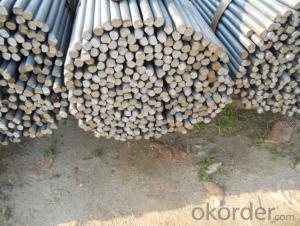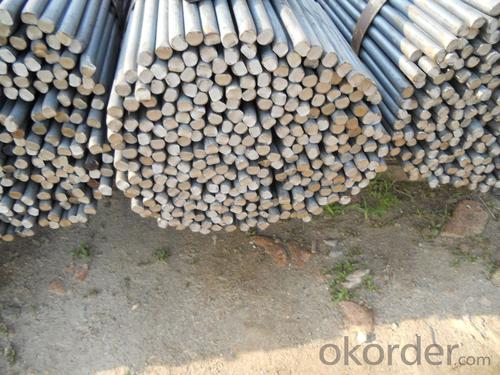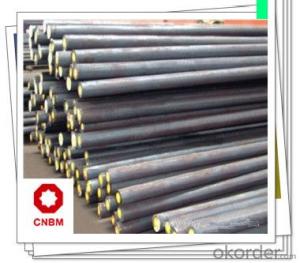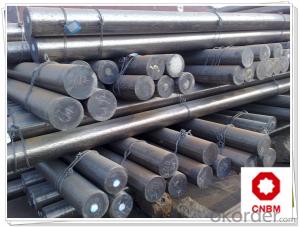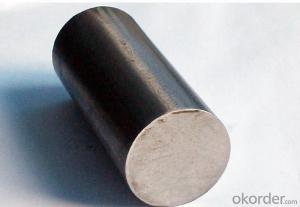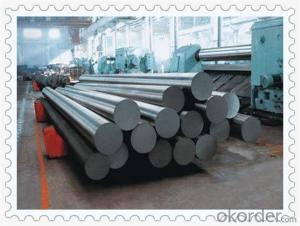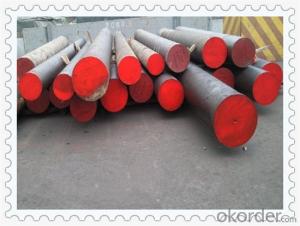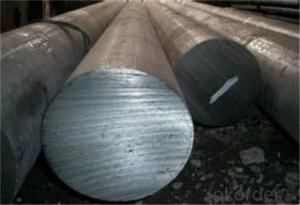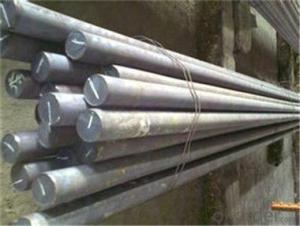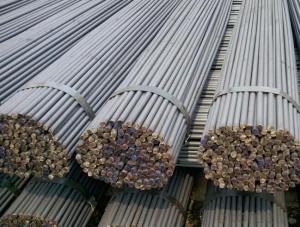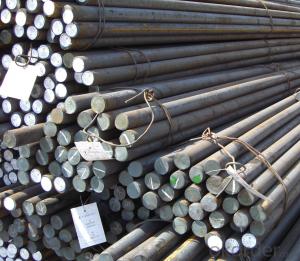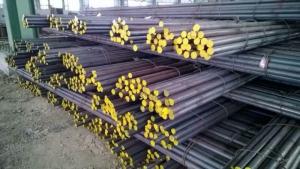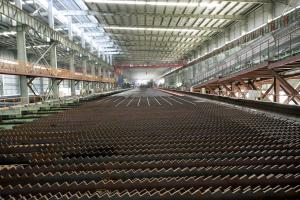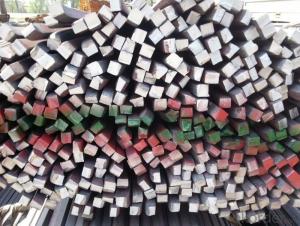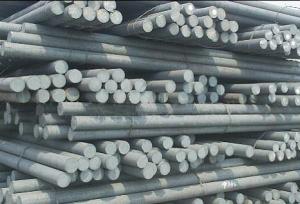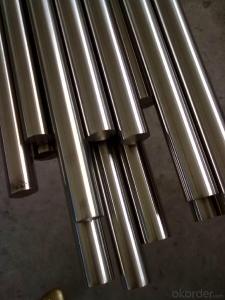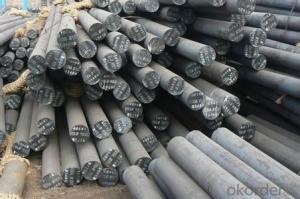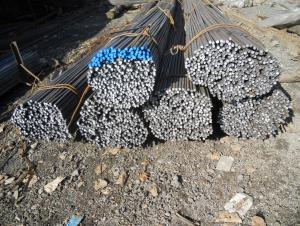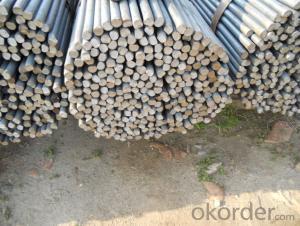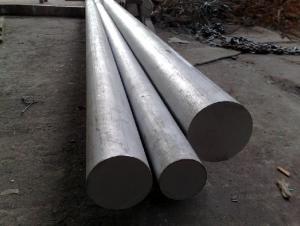Low Carbon Hot Rolled Steel Round Bar in Bundle
- Loading Port:
- China main port
- Payment Terms:
- TT OR LC
- Min Order Qty:
- 100 m.t.
- Supply Capability:
- 5000 m.t./month
OKorder Service Pledge
OKorder Financial Service
You Might Also Like
Product Description:
OKorder is offering Low Carbon Hot Rolled Steel Round Bar in Bundle at great prices with worldwide shipping. Our supplier is a world-class manufacturer of steel, with our products utilized the world over. OKorder annually supplies products to African, South American and Asian markets. We provide quotations within 24 hours of receiving an inquiry and guarantee competitive prices.
Product Applications:
Low Carbon Hot Rolled Steel Round Bar in Bundle are ideal for structural applications and are widely used in the construction of buildings and bridges, and the manufacturing, petrochemical, and transportation industries.
Product Advantages:
OKorder's Low Carbon Hot Rolled Steel Round Bar in Bundle are durable, strong, and wide variety of sizes.
Main Product Features:
· Premium quality
· Prompt delivery & seaworthy packing (30 days after receiving deposit)
· Can be recycled and reused
· Mill test certification
· Professional Service
· Competitive pricing
Product Specifications:
Manufacture: Hot rolled
Grade: Q195 – 235
Certificates: ISO, SGS, BV, CIQ
Length: 6m – 12m, as per customer request
Packaging: Export packing, nude packing, bundled
| ROUND BAR | |
| SIZE d(mm) | theoretical kg/m |
| 5.5 | 0.186 |
| 6 | 0.222 |
| 7 | 0.302 |
| 8 | 0.395 |
| 9 | 0.499 |
| 10 | 0.617 |
| 11 | 0.746 |
| 12 | 0.888 |
| 13 | 1.04 |
| 14 | 1.21 |
| 15 | 1.39 |
| 16 | 1.58 |
| 17 | 1.78 |
| 18 | 2 |
| 19 | 2.23 |
| 20 | 2.47 |
| 21 | 2.72 |
| 22 | 2.98 |
| 24 | 3.55 |
| 25 | 3.85 |
| 26 | 4.17 |
| 28 | 4.83 |
| 30 | 5.55 |
| 32 | 6.31 |
| 34 | 7.13 |
| 36 | 7.99 |
| 38 | 8.9 |
| 40 | 9.86 |
| 42 | 10.9 |
| 45 | 12.5 |
| 48 | 14.2 |
| 50 | 15.4 |
| 53 | 17.3 |
| 56 | 19.3 |
| 60 | 22.2 |
| 63 | 24.5 |
| 65 | 26 |
| 70 | 30.2 |
| 75 | 34.7 |
| 80 | 39.5 |
| 85 | 44.5 |
| 90 | 49.9 |
| 95 | 55.6 |
| 100 | 61.7 |
FAQ:
Q1: Why buy Materials & Equipment from OKorder.com?
A1: All products offered byOKorder.com are carefully selected from China's most reliable manufacturing enterprises. Through its ISO certifications, OKorder.com adheres to the highest standards and a commitment to supply chain safety and customer satisfaction.
Q2: How do we guarantee the quality of our products?
A2: We have established an advanced quality management system which conducts strict quality tests at every step, from raw materials to the final product. At the same time, we provide extensive follow-up service assurances as required.
Q3: How many tons of steel products could be loaded in containers?
A3: Usually the steel products are delivered by bulk vessel because of the large quantity and the freight. However, there are no bulk vessel enter some seaports so that we have to deliver the cargo by containers. The 6m steel product can be loaded in 20FT container, but the quantity is changed according to the size, usually from 18tons to 25tons.
Images:
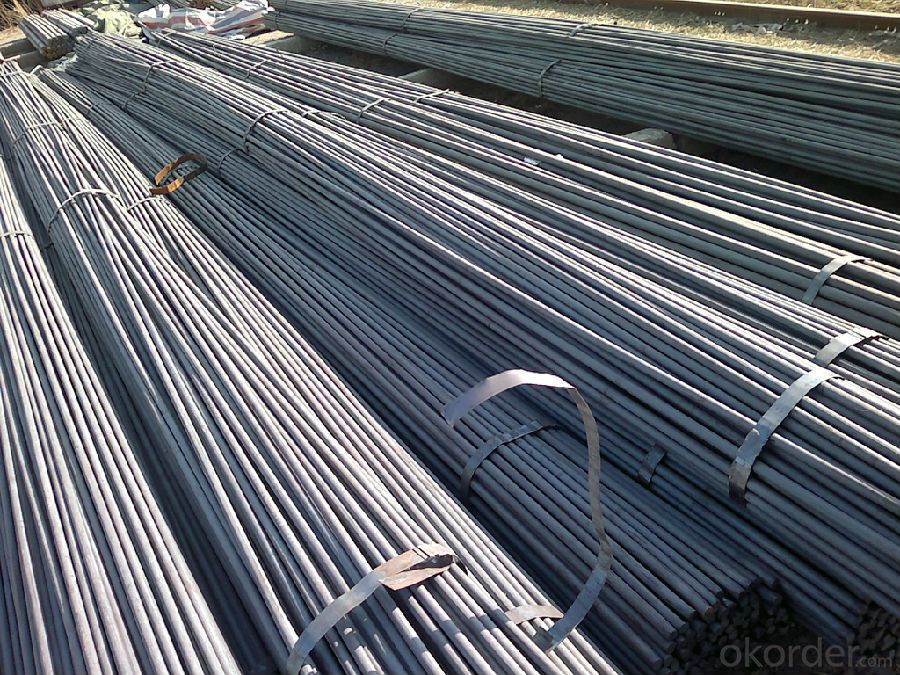
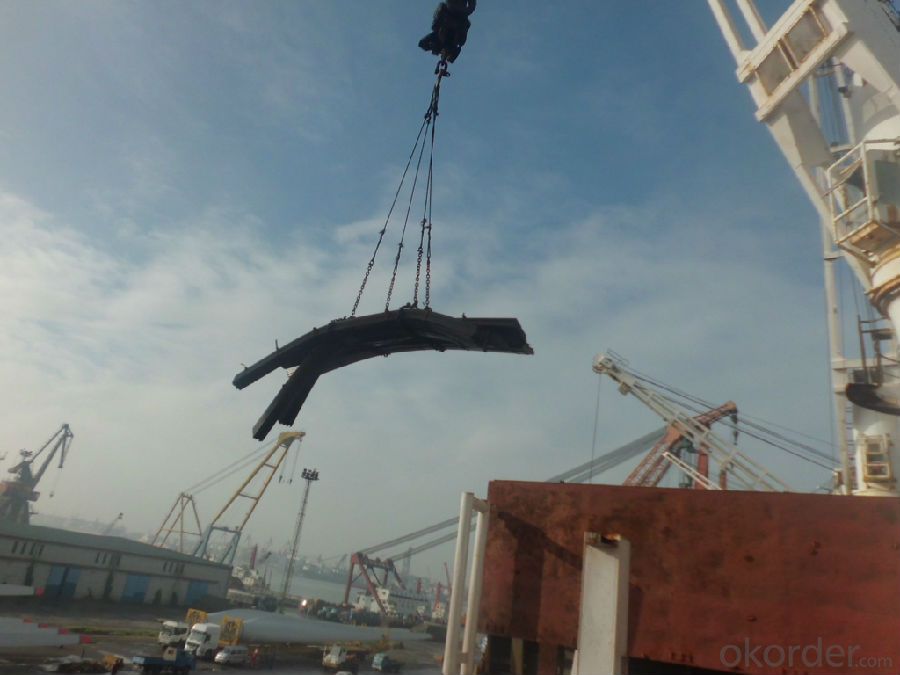
- Q: Are steel round bars susceptible to cracking?
- Yes, steel round bars can be susceptible to cracking under certain conditions. Cracking can occur due to factors such as excessive stress, improper handling, or poor manufacturing processes. However, the susceptibility to cracking can be minimized by using high-quality steel, proper heat treatment, and careful handling and installation techniques.
- Q: Are steel round bars recyclable?
- Yes, steel round bars are recyclable. Steel is one of the most commonly recycled materials in the world due to its high value and ease of recycling. When steel round bars reach the end of their useful life, they can be collected and sent to a recycling facility. At the recycling facility, the round bars are melted down and transformed into new steel products. This process can be repeated indefinitely without compromising the quality of the steel. Recycling steel round bars not only helps conserve natural resources and reduce waste but also saves energy and reduces greenhouse gas emissions compared to producing steel from raw materials.
- Q: Are steel round bars used in the aerospace industry?
- Yes, steel round bars are commonly used in the aerospace industry for various applications such as structural components, landing gears, and engine parts. The high strength, durability, and excellent mechanical properties of steel make it an ideal material choice for aircraft manufacturing.
- Q: How do you calculate the strength of a steel round bar?
- When calculating the strength of a steel round bar, several factors come into play. The primary consideration is the yield strength of the material, which signifies the stress level at which the steel permanently deforms. This value is typically provided by the manufacturer or can be found in engineering handbooks. The next step involves determining the cross-sectional area of the round bar. This can be achieved by measuring the bar's diameter and utilizing it to calculate the area using the formula A = πr^2, where A represents the cross-sectional area and r denotes the radius. Once the cross-sectional area is established, it becomes possible to calculate the ultimate tensile strength (UTS) using the formula UTS = Yield Strength / Safety Factor. The safety factor is a numerical value that takes into account uncertainties and potential variations in the material's strength. It is usually specified by design requirements or industry standards. Lastly, the maximum load that the steel round bar can endure before failing can be determined by multiplying the ultimate tensile strength by the cross-sectional area. This value represents the bar's strength and can be utilized to evaluate its suitability for a specific application. It is worth noting that other factors, such as the bar's length, shape, and any additional treatments or modifications, can also impact its strength. Therefore, it is recommended to consult with a structural engineer or refer to relevant design codes and standards to ensure accurate calculations and safe application of steel round bars.
- Q: How do you calculate the strength of a steel round bar?
- When calculating the strength of a steel round bar, several factors come into play. The primary consideration is the yield strength of the material, which signifies the stress level at which the steel permanently deforms. This value is typically provided by the manufacturer or can be found in engineering handbooks. The next step involves determining the cross-sectional area of the round bar. This can be achieved by measuring the bar's diameter and utilizing it to calculate the area using the formula A = πr^2, where A represents the cross-sectional area and r denotes the radius. Once the cross-sectional area is established, it becomes possible to calculate the ultimate tensile strength (UTS) using the formula UTS = Yield Strength / Safety Factor. The safety factor is a numerical value that takes into account uncertainties and potential variations in the material's strength. It is usually specified by design requirements or industry standards. Lastly, the maximum load that the steel round bar can endure before failing can be determined by multiplying the ultimate tensile strength by the cross-sectional area. This value represents the bar's strength and can be utilized to evaluate its suitability for a specific application. It is worth noting that other factors, such as the bar's length, shape, and any additional treatments or modifications, can also impact its strength. Therefore, it is recommended to consult with a structural engineer or refer to relevant design codes and standards to ensure accurate calculations and safe application of steel round bars.
- Q: What is the difference between a rough turned and a centerless ground steel round bar?
- A rough turned steel round bar refers to a steel bar that has been machined to a standard size and shape, typically using a lathe or turning machine. The process involves removing excess material from the bar's surface to achieve the desired diameter and smoothness. The resulting rough turned bar may still have slight imperfections or variations in size and surface finish. On the other hand, a centerless ground steel round bar undergoes a different manufacturing process. Centerless grinding involves feeding the steel bar through two rotating wheels: a grinding wheel and a regulating wheel. The grinding wheel removes material from the bar's surface to achieve a precise diameter, while the regulating wheel controls the bar's feed rate. This process ensures tight tolerances, excellent surface finish, and a uniform diameter along the entire length of the bar. In summary, the main difference between a rough turned and a centerless ground steel round bar lies in the manufacturing process and the resulting quality. While a rough turned bar is machined to a standard size and shape with some imperfections, a centerless ground bar undergoes a more precise grinding process to achieve a highly accurate diameter, excellent surface finish, and consistent dimensions throughout the bar.
- Q: What are the advantages of using nickel-iron alloy steel round bars?
- There are several advantages to using nickel-iron alloy steel round bars. Firstly, nickel-iron alloy steel has excellent resistance to corrosion and oxidation. This makes it highly suitable for use in environments where exposure to moisture, chemicals, or high temperatures is expected. The corrosion resistance of this alloy ensures that the round bars will maintain their structural integrity and durability over time, reducing the need for frequent replacements or repairs. Secondly, nickel-iron alloy steel round bars have excellent mechanical properties. They possess high strength, toughness, and hardness, making them suitable for applications that require heavy-duty performance. These round bars can withstand significant stress and load, making them ideal for use in various industries such as construction, manufacturing, and engineering. Additionally, nickel-iron alloy steel offers good thermal stability and resistance to thermal expansion. This means that the round bars will maintain their shape and dimensions even when exposed to extreme temperatures, ensuring their reliability and performance in high-temperature applications. Furthermore, nickel-iron alloy steel has excellent magnetic properties. It exhibits high magnetic permeability, making it suitable for electromagnetic applications such as transformers, inductors, and magnetic shielding. This property enables the round bars to efficiently conduct and distribute magnetic fields, enhancing the performance of these devices. Lastly, the versatility of nickel-iron alloy steel allows for various manufacturing processes and customization options. It can be easily machined, welded, and formed into different shapes and sizes, providing flexibility in design and application. This adaptability makes nickel-iron alloy steel round bars a preferred choice in many industries. In conclusion, the advantages of using nickel-iron alloy steel round bars lie in their corrosion resistance, excellent mechanical properties, thermal stability, magnetic properties, and versatility. These qualities make them reliable, durable, and suitable for a wide range of applications, ensuring optimal performance and longevity.
- Q: Can steel round bars be recycled?
- Yes, steel round bars can be recycled. Steel is a highly recyclable material, and the recycling process involves melting the steel bars down to be used in the production of new steel products.
- Q: What are the advantages of using niobium-alloy steel round bars?
- Niobium-alloy steel round bars offer numerous benefits. Firstly, they possess exceptional strength and toughness. By incorporating niobium, the steel's strength increases while maintaining its ductility, making it ideal for applications requiring durability and high strength. Consequently, these round bars can withstand heavy loads and shocks without deforming or breaking easily. Secondly, niobium-alloy steel exhibits high resistance to corrosion. Consequently, it proves suitable for use in harsh environments where exposure to moisture, chemicals, or corrosive substances is common. The corrosion resistance ensures that the round bars remain intact and retain their structural integrity over time, reducing the need for frequent replacements and maintenance. Moreover, niobium-alloy steel demonstrates excellent weldability and formability. It can be effortlessly welded and fabricated into various shapes and sizes, making it adaptable to different manufacturing processes and applications. This adaptability enables the production of custom-designed round bars that meet specific project requirements. Additionally, niobium-alloy steel possesses superior heat resistance properties. It can endure high temperatures without losing strength or experiencing significant changes in its mechanical properties. Thus, it proves suitable for applications involving exposure to extreme heat or thermal cycling, such as in the aerospace or automotive industries. Furthermore, niobium-alloy steel is renowned for its exceptional fatigue resistance. It possesses a high endurance limit, enabling it to withstand repeated loading and unloading cycles without experiencing fatigue failure. This quality makes niobium-alloy steel round bars ideal for applications involving dynamic or cyclic loading, such as in structural components or machinery. In conclusion, the utilization of niobium-alloy steel round bars grants advantages such as high strength, corrosion resistance, weldability, formability, heat resistance, and fatigue resistance. These properties make niobium-alloy steel a reliable and cost-effective choice for numerous industries and applications.
- Q: How do steel round bars perform in high-temperature environments?
- Steel round bars generally perform well in high-temperature environments. The performance of steel round bars in high-temperature conditions can be attributed to their high melting point and excellent heat resistance properties. Steel has a relatively high melting point compared to other materials, allowing it to withstand elevated temperatures without losing its structural integrity. Furthermore, steel round bars possess excellent thermal conductivity, which allows them to dissipate heat efficiently, minimizing the risk of deformation or structural failure. This property makes steel round bars suitable for applications where heat is generated, such as in industrial processes or high-temperature equipment. In addition to its high melting point and thermal conductivity, steel also demonstrates good mechanical strength at high temperatures. It retains its load-bearing capacity and dimensional stability, ensuring that it can withstand the stresses and strains imposed on it in high-temperature environments. However, it is important to note that the performance of steel round bars in high-temperature conditions may be influenced by the specific grade of steel used. Different grades of steel have varying compositions and alloying elements which can affect their performance at elevated temperatures. It is crucial to select the appropriate grade of steel that is specifically designed for high-temperature applications to ensure optimal performance and longevity. Overall, steel round bars are a reliable and durable choice for use in high-temperature environments due to their high melting point, excellent thermal conductivity, and mechanical strength.
Send your message to us
Low Carbon Hot Rolled Steel Round Bar in Bundle
- Loading Port:
- China main port
- Payment Terms:
- TT OR LC
- Min Order Qty:
- 100 m.t.
- Supply Capability:
- 5000 m.t./month
OKorder Service Pledge
OKorder Financial Service
Similar products
Hot products
Hot Searches
Related keywords
